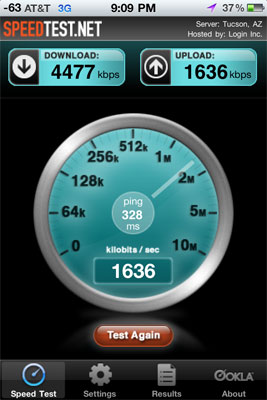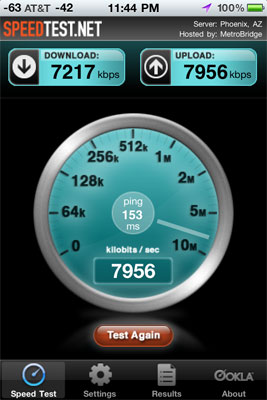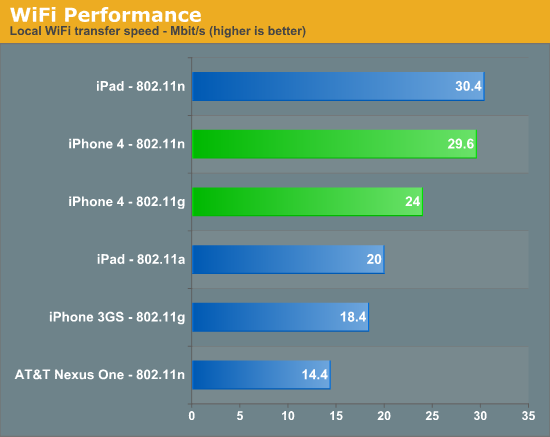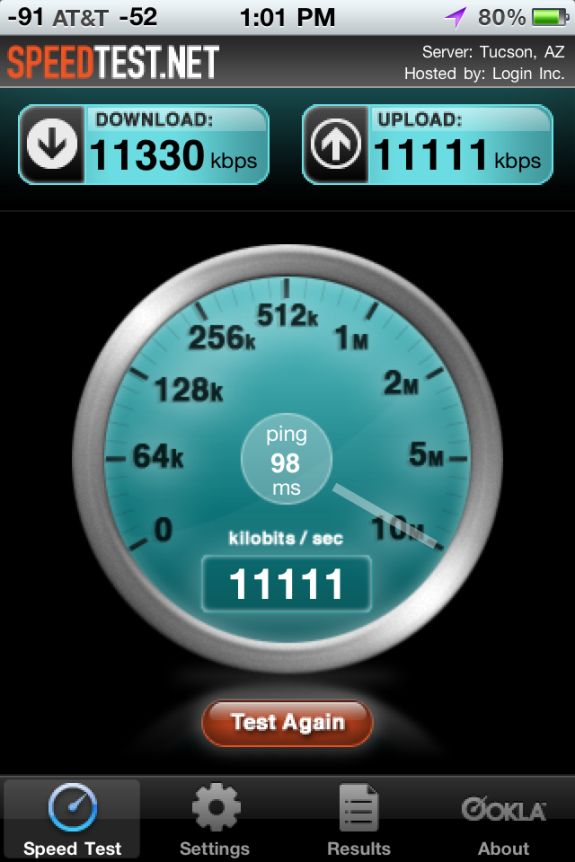Apple's iPhone 4: Thoroughly Reviewed
by Brian Klug & Anand Lal Shimpi on June 30, 2010 4:06 AM EST- Posted in
- Smartphones
- Apple
- iPhone 4
- Gadgets
- Mobile
Network Improvements
The iPhone continues to be an AT&T exclusive in the US. With the iOS 4 upgrades the iPhone 4 supports tethering over Bluetooth or USB. The feature is an extra $20 per month on top of your existing iPhone data plan and it also deducts bandwidth from the 2GB you get with the data plan. It's not a coincidence that AT&T timed the release of its iPhone tethering option with the move away from unlimited data plans. You don't have to give up your existing unlimited data plan if you don't want to, however if you want to enable tethering you have to sign up for the new $25/2GB plan.
I'm not a huge fan of iPhone tethering right now because despite paying for the service and having full signal strength on AT&T, I'm getting horrible transfer rates while trying to upload this article. I had to sign up for airport WiFi to get it live, thanks AT&T. When it does work however, it works well. As you'll see later you can easily get multiple Mbps out of AT&T's network in areas with good coverage. That easily equals the lower end of what you'd see from WiMAX today. As I've mentioned before however, it's really hit or miss with AT&T. The network is either great or totally unusable, while its competitors are generally more consistent but never quite as fast. I'd say that there's a good chance Apple will bring the iPhone to Verizon, it's just a matter of when.
| Cost of Ownership Comparison | |||||
| AT&T iPhone 4 | Sprint EVO 4G | Verizon HTC Droid Incredible | |||
| Cost of Device | $199 w/ 2 year contract | $199 w/ 2 year contract after $100 MIR | $199 w/ 2 year contract | ||
| Plan with 900 Minutes, Unlimited SMS/Data | $104.99/mo, unlimited SMS, 2GB data | $99.99/mo, unlimited SMS, unlimited data, 4G | $109.98/mo, unlimited SMS, unlimited data | ||
| Tethering | + $20/mo | + $29.99/mo | + $25/mo* | ||
| Total Monthly + Tethering | $124.99/mo | $129.98/mo | $134.98/mo | ||
| Total Cost of Ownership over 2 Years | $2718.76 | $2598.76 after $100 MIR | $2838.52 | ||
| Total Cost of Ownership over 2 Years w/ Tethering | $3198.76 | $3318.52 after $100 MIR | $3438.52 | ||
AT&T's plans are actually reasonably priced if you don't go over the data limits. A $15/mo data plan will get you 200MB of transfers per month and $25 will give you 2GB. For users like my parents the 200MB option is great. Even for me personally, 2GB is fine. I tend to peak at 700MB per month, but that's because at the office I'm almost always on my desktop or connected via WiFi. It's unclear how tethering is going to change this for me. Our own Brian Klug on the other hand easily pushes more than 2GB of transfers per month. So AT&T's rate switch is either going to save you a few bucks per month or make you really unhappy.
The iPhone 4 brings HSUPA class 6 for upload speeds of up to 5.76 megabits/s to the platform. This is a 15 fold improvement over the 384 kilobits/s maximum of the iPhone 3G and 3GS, which I routinely see. Not all AT&T markets are updated to HSUPA, and in practice I saw uploads of around 1.5 megabits/s, in line with class 2 or class 3 HSUPA.
Downstream HSDPA speeds remain unchanged from the 3GS, supporting up to 7.2 megabit/s HSDPA. I'm lucky since my market is HSDPA 7.2, as I routinely see speedtests of 5 megabits/s or above very late at night when there isn't very much plant load. I haven't seen any measurable increase in speeds over the 3GS, except in locations with very low signal as noted before.

My fastest iPhone 4 speedtest so far
Even Anand in one of the slowest 3G cities in the US saw significant improvements with the iPhone 4. AT&T's network in general seems to be improving. While the best he'd been able to achieve was around 1Mbps a year ago, these days he can break 2.5Mbps down during the evenings.

iPhone 4 speedtest in Raleigh, NC
WiFi speeds have also improved, as Apple has added 802.11n in the 2.4 GHz band. 5 GHz support remains absent, something which would have likely complicated antenna design even further. Interestingly enough, the BCM4329 WiFi and Bluetooth SoC does contain 802.11a 5 GHz support, the reason it's disabled is again likely due to antenna design constraints. The Broadcom SoC also includes an FM tuner and transmitter, though support for either remains and sadly (given Apple's historical lack of FM radio support) will remain such. Bluetooth 2.1 EDR is there as well.
The iPhone 4 seems to connect at 802.11n rates of 72 megabits/s in best case, far from the maximum without channel bonding of 150 megabits/s. This is still a welcome improvement from the 802.11b/g in the iPhone 3GS, which seemed to never connect above b rates in practice. As an aside, mobile devices using 802.11b rates (modulated using DSSS) are a huge contributing factor to WiFi congestion at conferences - I've even seen DSSS modulated rates (and thus 802.11b devices) explicitly disallowed from connecting to APs at conferences. It's a welcome improvement to see iPhone bringing N support.

A typical WiFi test result
However, even on my 25/4 DOCSIS 3 cable connection, I could only squeeze out a maximum of 8.5 megabits/s down and 8.0 megabits/s up while connected at 72 megabits/s best case. This was using the speedtest.net app to a local test location. I tried with an Airport Extreme (new generation), a WRT600N running DD-WRT, and a WRT54GL-TM running Tomato. All three showed similar results capping out around 8 megabits/s down when I could run tests in excess of 30 megabits down on my desktop. This is probably more of a CPU bottleneck appearing than anything else.
Update:
I thought there was something wrong with my WiFi performance, turns out the iPhone 4 is indeed faster than a palty 8 megabits/s. ;)
There were a number of comments by folks who were able to run speedtest.net and get throughput above 10 or 11 megabits/s. Testing earlier today on a much faster connection, I managed to get something in line with their numbers:
Early today, the folks at DigitalSociety also managed to get much faster WiFi speeds in the neighborhood of 20 megabits/s, way higher than my meager 8 megabits/s. To do so, they loaded an MP3 in safari stored on a local webserver and watched network utilization. I wish I had thought of this, because it's perfect. In the past, the speedtest.net app always used to saturate my connection over WiFi. My only explanation is that the application performs slower over WiFi in iOS 4 than it did in iOS 3, something Anand noted as well. Thanks for all the heads up messages, everyone!
I set up a similar test to DigitalSociety's. I opened an 85 MB PDF stored on my local web server in the browser of each device and watched network utilization using bwm-ng. I tested with an Airport Extreme connected over gigabit to my webserver with no other network utilization. I took the average of 5 runs on the iPad, iPhone 4, iPhone 3GS, and my AT&T Nexus One running Froyo 2.2 (which is 802.11n). The results are much, much more in line with earlier expectations.

The iPhone 4 comes close to but can't quite best the iPad, though the difference is minimal. I did notice that the iPad associates at the same 72 megabits/s connection speed as the iPhone 4. Thankfully, the iPhone 4 easily bests the iPhone 3GS. Finally, although the AT&T Nexus One associates at an 802.11n rate of 65 megabits/s, it's slower than the iPhone 3GS. I have a feeling the device is writing the PDF into flash, whereas the iOS devices are loading it into memory.











270 Comments
View All Comments
Griswold - Wednesday, June 30, 2010 - link
Lets be honest, he has only very limited means to meassure the problem. To get to the bottom of this, it needs to be meassured in a HF lab.samspqr - Wednesday, June 30, 2010 - link
"The fact that Apple didn't have the foresight to coat the stainless steel antenna band with even a fraction of an ounce worth of non-conductive material either tells us that Apple doesn't care or that it simply doesn't test thoroughly enough."I find it really funny that they would never catch this specific problem because of them just being apple: if their engineers are not as good as anand is (as in thinking "that's gonna be a problem" right after hearing the description of the antenna), and if THE FIELD TESTERS HAD THEIR PHONES DRESSED AS A 3GS BECAUSE OF PARANOID ISSUES, this kind of problem can only slip through
The0ne - Wednesday, June 30, 2010 - link
I think Anand was a little light on this topic. As an multi-discipline engineer myself this type of problem with the Antenna SHOULD NEVER had happened. It can only happened due to decisions that did not properly address it. This is not rocket science to engineers. If anything, testing WOULD HAVE discover the problem and yet it's in the finish product. Quite sad if you ask me.For example, why put a ferrite clamp on the end of the cable instead of designing it into the PCB . The only reason I can see why we did this was due to lack of time and we severely paid for it by having products become defective because the ferrite would pull the cables loose from the connectors.
deppbv78 - Wednesday, June 30, 2010 - link
I'm really disappointed at the lengths taken by AT to justify that iP4 losing signal as not a big deal...If it was any other product from any other manufacturer, I'm sure you'd not have gone to such lengths to justify the signal drop and just concluded that the phone has serious antenna problems. I'm not understanding why is it so difficult for anyone just provide an unbiased view of the product.I have HTC Hero & Touch Pro both of which lost a bar or two (with fluctuations) when cupped tightly. However, it was always just 1-2 bars and never went down like iPhone 4 does from 5 bars to 0. This continuous loss of signal is the problem. Justifying it telling that all phones lose signal is not right, as every other phone (including 3GS) loses signal temporarily and then stabilizes unlike iPhone 4.
No wonder the iPhone 4 is engineering marvel, but that set aside it is also true that the design has created issues as well and the reviews need to acknowledge it and not justify it
geniekid - Wednesday, June 30, 2010 - link
HTC Incredible owner here. I think AT successfully showed that the antenna issue is NOT a big deal and their methods for doing so are sound. I share your suspicion that maybe they wouldn't have made such a significant investigation if it had been another phone, but let's not accuse them of mistakes they haven't made yet.bplewis24 - Wednesday, June 30, 2010 - link
I have a sincere question though. Does this test really successfully show the antenna issue is NOT a big deal, or does it simply show that it's not a big deal in the utmost ideal conditions?Sometimes the article is difficult to decipher in terms of understanding who is saying what, but upon my initial reading I take it Brian did the testing of the antenna in Arizona. By his own admission (from my understanding), he lives there because the reception is absolutely stellar and about as good as it can possibly be.
Again, from what I can tell, it is under those conditions that he conducted the attenuation signal loss comparisons. If it still drops down to 1 bar and comes reasonably close to dropping calls under the best possible conditions, how does it react under "average" conditions? Other people are reporting dropped calls for a reason. Is Brian's test the norm or an outlier?
Please correct me if I've read this article wrong.
Brandon
anactoraaron - Wednesday, June 30, 2010 - link
My understanding is you are partially correct in assuming (which is what I interpreted from your post) that under "normal" or "average" conditions you will go to one bar - which with the improved reception even at 1 bar you are still fine - OR will drop signal completely.This is also the reason why they say "At the bare minimum Apple should give away its bumper case with every iPhone 4 sold."
Again, fantastic in-depth review.
strikeback03 - Thursday, July 1, 2010 - link
Well, he said the location he lives in has stellar reception. But he also said he drove around for a day testing, which implies to me that he found somewhere with a stable, "average" signal and did some testing there, then probably went somewhere with a "poor" signal and did some more, etc.bplewis24 - Friday, July 2, 2010 - link
@strikeback03Correct. And in driving around to the less-than-stellar areas showed the phone dropping down below -107dB for reception when showing less than 2 bars. And this is on the low end of the reception spectrum as described earlier in the article. So it's pretty clear that the antenna does INDEED show poor signal strength in average or less than average areas when the "death grip" is applied.
That is the determining factor. That determines that the design is defective and flawed. If it was not designed that way, when in average or below signal areas, the reception would still be average or below, and not well below because of the way you hold the phone.
However, the article skirts this and attempts to present it in a way that shines the best possible light on Apple and their defective design. Big disappointment in terms of an objective review.
Brandon
geniekid - Wednesday, June 30, 2010 - link
The article made it clear that bars are a misleading way of measuring call quality/reception. In practice, it was noted that call quality/reception is improved/equal to the 3GS on the 4, regardless of bars (raw signal power).Who cares if you have 1 bar all the time if you're still making calls better than someone with 4 bars?
HTC Incredible owner here.